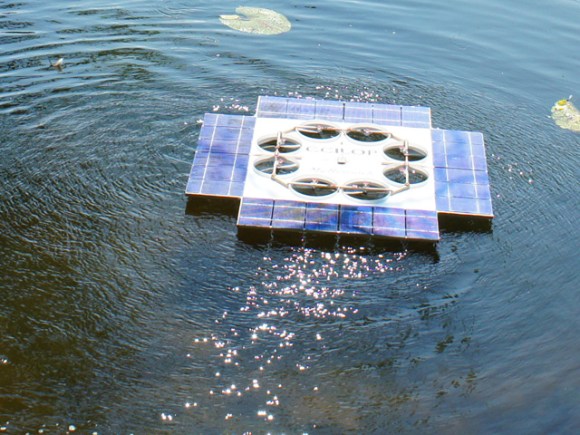
It looks a little bit like an octocopter, but this solar-powered hovercraft is distinctly different from its free-flying brethren. It depends mostly on ground effect for operation and to get it just a bit into the air you need a pretty large reflective rig nearby.
The vehicle needs to be even lighter than traditional quadcopters in order to function. It doesn’t carry any battery at all which presents a problem when trying to program the microcontroller board. For this it is connected to an external battery, which is removed before flight so that the control can be powered from the solar array.
What’s not shown in the image above is a mirror array used to focus more intense sunlight on the panels to bump up the available electricity. Not much is said about this, but there is one image on the project page which shows the creator standing in front of the set of four mirrors (perhaps sheets of mylar?) strung up between a couple of trees.
Alas, we couldn’t find a video of the aircraft in action. With such a delicate balsa wood frame we’re sure this thing is affected by every air current that passes its way.
[Thanks Laimonas]















Here is a video
forgot to add a link: http://vimeo.com/68074303
Couldn’t fit many eels in that hovercraft.
I think they wouldnt need any reflector’s IF they covered the middle bit with a solar panel
Probably get twice the surface area than just the outside 4.
You would have to raise the panels up about 1 cm, to allow air to reach the fans, though.
Actually is the same exact area the side panels cover all together ,and if the middle of the craft was covered with one panel the sides should have been covered with the motors so its the same thing …
Pretty sure he meant in addition to the ones that are there now.
Solar panels weigh something though…
Wouldn’t it be easier to achieve a good compression ratio if the blades had more fins on them? It just seems like you would have to spin about 2x as fast as a 4-bladed prop to keep the cushion of air sustained. I understand there will be additional air drag for each prop, anyone have insight to this thought?
True that it would have a better compression ratio, but yes, there would be about twice as much resistance. This thing is solar powered, so more torque that the motors need to exert isn’t necessarily a good thing…
I wonder how more efficient those motors are at low speeds vs high speeds. Also would be interesting to see the efficiency of fan blade shapes.
That’s exactly the sort of thing I like to see on hackaday. Beautiful job!
it’s really NOT an overcraft…. it’s just a solar powered multicipter. and a bad one. there are better working models that fly much better and higher.
Have you heard the term “ground effect vehicle”?
You mean those Honda Civics with loud mufflers and blue lights underneath? Lol!
Yes, this is a hovercraft.
When I was a kid, they were called Ground Effects Machine or GEM,
now, git off’n my lawn! B^)
Interesting , sort of a poor man’s “Lightcraft”.
A couple of ideas to decrease weight, are to use copper PCB stock of the ultra thin variety then Al plate over it to increase the current capacity and overplate that with copper.
Ought to work, the newer microwave inverter transformers and older style are wound this way and not many fail in the field.
Also worth trying is to use a downconverter over the cell(s) based on a rare earth phosphor such as BaS:Cu as small dots to convert visible light into red.
I’m seeing a lot of thrust discussion and nothing about the missing piece for a hovercraft to work well – the skirt underneath that allows the pressure rise that lifts the craft higher than the “leakage” altitude where all the compressing is bled away around the sides.